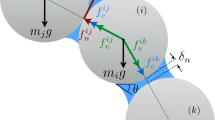Abstract
Based on the theoretical analyses, the adhesion process of fine gold particles to oil-carbon agglomerates in a dynamic system was quantitatively investigated in terms of the relationship between the attachment probability and the surface energy. The proposed way to establish this relationship is to firstly theoretically derive the formula to evaluate the surface energy change of the system by analyzing the adhesion process of a gold particle on an oil-carbon agglomerate in a mathematic and thermodynamic way. The obtained formula of the maximum energy change of unit surface area is, Δw′max=1/2σhw(cos ϑ−1), which involves two measurable elements: interfacial tension and contact angle. In a well-quantified system, based on the related model it is also possible to calculate the complicated concept, namely, the attachment probability by transferring other measurable indices. In this way, after some adhesion experiments and measurements of relevant parameters, the empirical relationship between the attachment probability and the surface energy change was established in an exponential function, P a=Aexp(−ΔG surf/k).
Similar content being viewed by others
References
Schulze H J. Physical-chemical Elementary Processes in Flotation[M]. New York: Elsevier, 1984.
Anfruns J F, kitchener J A. Flotation [M]. New York: AIME, 1976,2.
Solari J A, Gochin R J. Colloid Chemistry in Mineral Processing[M]. New York: Elsevier, 1992.
Polat M, Chander S. First-order flotation kinetics models and methods for estimation of the true distribution of flotation rate constants [J]. Int J Miner Process, 2000,58(3): 145–166.
Cadzow M, Lamb R. CARBAD gold recovery[A]. Randol International Gold Conference [C]. Nevada, USA, 1989.
House C I, Veal C J. Coal gold agglomeration-pilot scale retreatment of tailings[A]. Randol International Gold Conference[C]. Perth, Australia, 1988.
ZHAO B, LU L S. Application of ‘air-lift’ adsorption tower in CGA process[J]. Gold, 1997, 18(6): 38–42, (in Chinese)
Calvez J P S, Kim M J. Use of coal-oil agglomerate for particulate gold recovery[J]. Minerals Engineering, 1998, 11(9): 803–812.
House C, Townsend I and Veal C J. Coal gold agglomeration [J]. International Mining, 1988, 50(9): 17–19.
WU X Q. Modelling Carbon-gold-oil Agglomeration [D]. London: Imperial College Library, 2002.
Erb R A. Wettability of metals under continuous condensation conditions[J]. J Phys Chem, 1965, 69(4): 1306–1309.
Aksoy B S, Yarar B. Natural hydrophobicity of native gold flakes and their flotation under different conditions[A]. Proceedings of Complex Ores[C]. Halifax, Nova Scotia, 1989.
Christina R, Hamelmand A, Lins F F. A non-polluting technology to recover gold: the gold-paraffin process[A]. Proceedings of the 20th IMPC [C]. Aachen, 1997.
Author information
Authors and Affiliations
Corresponding author
Additional information
Foundation item: Project supported by Scholarship of Imperial College, University of London
Rights and permissions
About this article
Cite this article
Wu, Xq., Monhemius, A.J. & Gochin, R.J. Relationship between attachment probability and surface energy in adhesion process of gold particles to oil-carbon agglomerates. J Cent. South Univ. Technol. 10, 318–323 (2003). https://doi.org/10.1007/s11771-003-0031-9
Received:
Accepted:
Issue Date:
DOI: https://doi.org/10.1007/s11771-003-0031-9




